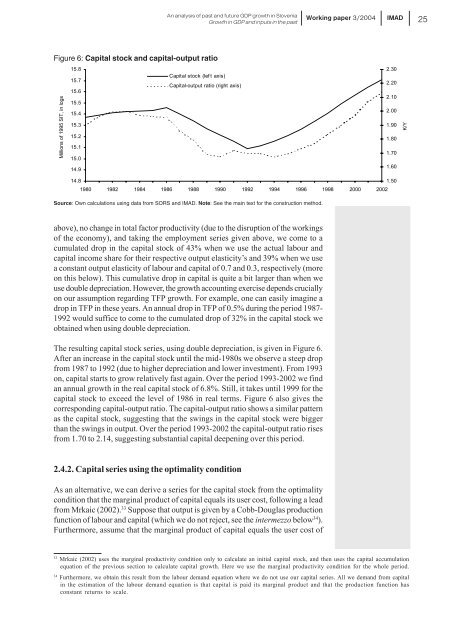Working papers published by IMAD ISSN: 1318-1920 ... - UMAR
Working papers published by IMAD ISSN: 1318-1920 ... - UMAR
Working papers published by IMAD ISSN: 1318-1920 ... - UMAR
You also want an ePaper? Increase the reach of your titles
YUMPU automatically turns print PDFs into web optimized ePapers that Google loves.
An analysis of past and future GDP growth in Slovenia<br />
Growth in GDP and inputs in the past<br />
<strong>Working</strong> paper 3/2004<br />
<strong>IMAD</strong><br />
25<br />
Figure 6: Capital stock and capital-output ratio<br />
Millions of 1995 SIT, in logs<br />
15.8<br />
Capital stock (left axis)<br />
15.7<br />
Capital-output ratio (right axis)<br />
15.6<br />
15.5<br />
15.4<br />
15.3<br />
15.2<br />
15.1<br />
15.0<br />
14.9<br />
2.30<br />
2.20<br />
2.10<br />
2.00<br />
1.90<br />
1.80<br />
1.70<br />
1.60<br />
K/Y<br />
14.8<br />
1.50<br />
1980 1982 1984 1986 1988 1990 1992 1994 1996 1998 2000 2002<br />
Source: Own calculations using data from SORS and <strong>IMAD</strong>. Note: See the main text for the construction method.<br />
above), no change in total factor productivity (due to the disruption of the workings<br />
of the economy), and taking the employment series given above, we come to a<br />
cumulated drop in the capital stock of 43% when we use the actual labour and<br />
capital income share for their respective output elasticity’s and 39% when we use<br />
a constant output elasticity of labour and capital of 0.7 and 0.3, respectively (more<br />
on this below). This cumulative drop in capital is quite a bit larger than when we<br />
use double depreciation. However, the growth accounting exercise depends crucially<br />
on our assumption regarding TFP growth. For example, one can easily imagine a<br />
drop in TFP in these years. An annual drop in TFP of 0.5% during the period 1987-<br />
1992 would suffice to come to the cumulated drop of 32% in the capital stock we<br />
obtained when using double depreciation.<br />
The resulting capital stock series, using double depreciation, is given in Figure 6.<br />
After an increase in the capital stock until the mid-1980s we observe a steep drop<br />
from 1987 to 1992 (due to higher depreciation and lower investment). From 1993<br />
on, capital starts to grow relatively fast again. Over the period 1993-2002 we find<br />
an annual growth in the real capital stock of 6.8%. Still, it takes until 1999 for the<br />
capital stock to exceed the level of 1986 in real terms. Figure 6 also gives the<br />
corresponding capital-output ratio. The capital-output ratio shows a similar pattern<br />
as the capital stock, suggesting that the swings in the capital stock were bigger<br />
than the swings in output. Over the period 1993-2002 the capital-output ratio rises<br />
from 1.70 to 2.14, suggesting substantial capital deepening over this period.<br />
2.4.2. Capital series using the optimality condition<br />
As an alternative, we can derive a series for the capital stock from the optimality<br />
condition that the marginal product of capital equals its user cost, following a lead<br />
from Mrkaic (2002). 33 Suppose that output is given <strong>by</strong> a Cobb-Douglas production<br />
function of labour and capital (which we do not reject, see the intermezzo below 34 ).<br />
Furthermore, assume that the marginal product of capital equals the user cost of<br />
33<br />
Mrkaic (2002) uses the marginal productivity condition only to calculate an initial capital stock, and then uses the capital accumulation<br />
equation of the previous section to calculate capital growth. Here we use the marginal productivity condition for the whole period.<br />
34<br />
Furthermore, we obtain this result from the labour demand equation where we do not use our capital series. All we demand from capital<br />
in the estimation of the labour demand equation is that capital is paid its marginal product and that the production function has<br />
constant returns to scale.
















